The History of Outboard Motors – Part Thirteen
The 1970’s, 80’s and 90’s. By the 1970’s outboard motors had evolved into tried and true basic designs and systems that carried over for decades with minor improvements along the way. Horsepower was always being increased in order top or at least compete with the other manufacturers. Boat propeller performance also had to be improved so the higher horsepower engines worked at their optimum peak. The more powerful engines created more torque on the boat propellers so engineers came up with stainless steel propellers to handle the torque that caused aluminum propellers to flex down in pitch that made less speed. Stainless steel props do not flex, they are about seven times stronger than aluminum props.
Other improvements made on propellers was cupping (curling ) of the tip ends on the blades that got a better bite on the water with less slippage. Increasing the angle of rake on the blades created more bow lift that got more of the boat out and above the water creating more speed also.
Pontoon boats which use outboard motors became very popular and also the low profile go fast style outboard motor bass boats with the wild metal flake colors started flying across the water ways.
Two cycle motors had to have lubricating oil added to the gas manually but automated oil injection started being used and was a great improvement. New fuel injection motors became popular instead of carburated motors because they increase performance and have better gas milage. Many manufacturers that offered only two stroke motors started making four stroke environmentally friendly motors that are quieter and get better gas milage.
Boat propellers kept up with the motor improvements with four and five bladed propellers and more efficient and faster designs.
The History of Outboard Motors – Part Twelve
Japanese outboard motors. Honda, Suzuki, Tohatsu/Nissan and Yamaha are the Japanese companies that manufacture outboard motors. They all started out making other motorized things including motorcycles and got into outboards in the 1950’s and 60’s and they all are still in business today.The boat propellers used on these early engines were all made out of aluminum and mostly 2 bladed boat props.
It is believed that the first outboard produced by a Japanese company was a Tohatsu 1.5 horsepower air cooled 2 stroke model named the OB-2 that came out in 1956 and was used primarily by Japanese fisherman. Today Tohatsu is the second leading manufacturer of outboards in the world.
Yamaha started work on the development of their first outboard engine in 1958 with an engineering staff of two people. Starting from scratch, the research was done by making prototypes and running them until they broke down then they would improve on the parts that broke. Their first production model came out in 1960, it was the P-7, a 5.5 horsepower 2 stroke motor.
Honda was third Japanese company to produce an outboard motor with their 1964 GB-30, a 4 horsepower 4 stroke motor. Honda has pioneered the development and production of 4-stroke outboard engines and Honda boat propellers with a low impact on the environment based on the philosophy of their founder, Soichiro Honda, that “Watercraft should not pollute the waters they ply”.
Suzuki is the oldest of the four Japanese companies. Started in 1909 as a loom manufacturer. They began making outboard engines in 1965 when they introduced their D-55 model that was a 5.5 horsepower 2 stroke motor.
There is not much information on any of these early engines for some reason outside of the first ones produced. And practically nothing about the boat props they put on them.
The History of Outboard Boat Motors – Part Eleven
The 1960’s. OMC and Mercury continued the competition between themselves as the leaders of the industry. Other outboard motor makers such as Homelite and Scott-Atwater ( McCulloch ) were less popular and sold far less units than the big two. This decade saw fiberglass boats sales explode and wood pleasure boats started to disappear.
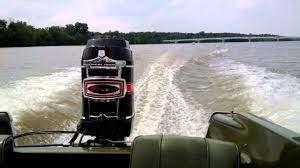
Mercury started the new decade by dropping their Mark model name and started using numbers only. The Mark 10 became the Mercury 100, the Mark 80 was changed to mercury 800 and so on. In 1961 Carl Kiekhaefer decided to merge with the Brunswick corporation in order to greatly expand operations. 1962 was an important year for Mercury because they introduced thru hub exhaust Mercury boat propellers with bigger more efficient blades. The first mass production 100 horsepower outboard, the merc 1000 was unveiled and the old 1950’s white paint scheme was change to black. Improvements went on thru the 60’s and in 1968 Mercury came out with a 125 horsepower Merc 1250 model. In 1970 Keikhaefer left the company.
 Evinrude – Johnson continued making better, more reliable motors with a model lineup starting with a 3 Horsepower single cylinder engine up to a 100 horsepower V-4 engine. These all were great motors that pleasure boaters loved because of their great looks, dependability, good speed and power. The higher horsepower models were the best to have for pulling water skiers.
Evinrude – Johnson continued making better, more reliable motors with a model lineup starting with a 3 Horsepower single cylinder engine up to a 100 horsepower V-4 engine. These all were great motors that pleasure boaters loved because of their great looks, dependability, good speed and power. The higher horsepower models were the best to have for pulling water skiers.
OMC’s best selling engines were the 35 and 40 horsepower models. OMC outboards started using the better performing thru hub exhaust boat propellers in 1968, 6 years after Mercury.
The History of Outboard Boat Motors – Part Ten
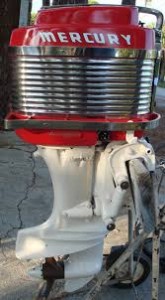
The 1950’s. This decade was a time when two manufacturers became the dominate outboard motor makers. Evinrude-Johnson ( OMC ) and Mercury Marine. Mercury fast out paced OMC after WW II ended until about 1950 and 1951 when Evinrude came out with newer designed motors that sported a gear shift handle the Mercury engines did not have until a few years later. They had two blades and Mercury three blade boat propellers designs, aluminum propellers and bronze props became popular. Major improvements in boat props did not happen until the 1960’s. The competition to out do the other guy saw a burst of new innovations yearly. In 1954 Mercury came out with thier Mark 50 which was a 40 horsepower in-line four cylinder engine that was far ahead of the Evinrudes that only had a twin cylinder 30 horsepower motor. In 1957, Mercury introduced an in-line six cylinder seventy five horsepower outboard motor that dominated the speed race for motors.
Evinrude produced a vee-four fifty horsepower motor in 1958 but it could not compete with the 75 Mercury for speed but it could pull up a water skier better because it had more torque. During this time Mercury became known for speed and the Evinrude-Johnsons propellers and motors were known for power and reliability. This held true for many years.
As with the rest of the economy in the 1950’s, people discovered recreational boating in mass and sales for boats and motors sky rocketed. Horsepower and speed increased pretty much every year. Boat propeller design became much more important as the quest for speed and power increased. The creation of boats that could be steered with a steering wheel, shifted and throttled from a forward position became most popular and the run-about was born. Fiberglass boats also started to be produced in high numbers and became more in demand than the older style wood boats because they are much easier to maintain and looked more modern. Water skiing also boomed and the boating industry as a whole just exploded upwards.
The History of Outboard Motors – Part Nine
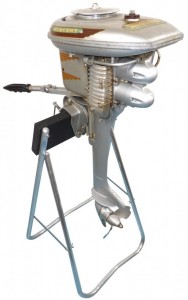 When world war II ended in 1945, Mercury was ready with two new motor models. A 3.2 horsepower single cylinder called the Comet and the twin cylinder 6 horsepower named the Rocket. In 1947 the engines were redesigned with a much more modern look and a third model was added called the Lightning. This new model was a higher RPM, 20 cubic inch, 10 horsepower rated motor that many experts claim was more powerful and with a better boat propeller design that could outrun many of it’s competitors 15 and 20 horsepower engines. The new Mercury boat propeller designs and engine power began the legend of Mercury’s speed.
When world war II ended in 1945, Mercury was ready with two new motor models. A 3.2 horsepower single cylinder called the Comet and the twin cylinder 6 horsepower named the Rocket. In 1947 the engines were redesigned with a much more modern look and a third model was added called the Lightning. This new model was a higher RPM, 20 cubic inch, 10 horsepower rated motor that many experts claim was more powerful and with a better boat propeller design that could outrun many of it’s competitors 15 and 20 horsepower engines. The new Mercury boat propeller designs and engine power began the legend of Mercury’s speed.
In 1949 the rivalry between Evinrude and Mercury was on and the performance war started to heat up. Mercury came out with a 4 cylinder, 40 cubic inch, 25 horsepower model named the Thunderbolt and was advertised as a 25 H.P. plus engine. This new model most likely had at least 40 horsepower and was “blowing the doors off” Evinrude’s bigger 50 H.P. boat engines at the time.
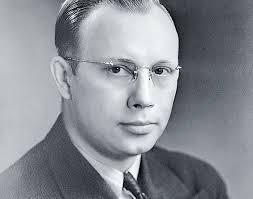 Mr. Kiekhaefer became annoyed with the notion that many people then believed that Ole Evinrude was the father of the outboard boat motor because published articles of Evinrude’s ice cream story kept popping up that most likely came out for Evinrude and were used as advertising for their motors. He hired a company to research old U.S.patents and they found out that Cameron Waterman, mentioned in part two of this series of our blogs, was selling outboard motors in 1905 that was 4 years before Evinrude. As a publicity move Mercury found seventy one year old Mr. Waterman in Detroit and gave him an expense free invitation to the New York boat show then and publicly honored him there in front of writers and newspaper people as the real father of outboard motor companies. He received an official looking plaque and was given a new Mercury motor. Needless to say this went over like a lead balloon with the Evinrude people at the show.
Mr. Kiekhaefer became annoyed with the notion that many people then believed that Ole Evinrude was the father of the outboard boat motor because published articles of Evinrude’s ice cream story kept popping up that most likely came out for Evinrude and were used as advertising for their motors. He hired a company to research old U.S.patents and they found out that Cameron Waterman, mentioned in part two of this series of our blogs, was selling outboard motors in 1905 that was 4 years before Evinrude. As a publicity move Mercury found seventy one year old Mr. Waterman in Detroit and gave him an expense free invitation to the New York boat show then and publicly honored him there in front of writers and newspaper people as the real father of outboard motor companies. He received an official looking plaque and was given a new Mercury motor. Needless to say this went over like a lead balloon with the Evinrude people at the show.
Dan’s Discount Props sells the best Mercury outboard propellers as well as Evinrude propellers or all other boat engine types at discount prices.
The History of Outboard Motors – Part Eight
The 1940 Mercury outboard boat motor was a very good looking streamlined motor compared to other brands at the time. The drive shaft was put inside a casing that also served to cover the water pickup line and a leak proof under water exhaust system. The water pump was also a huge leap forward in design using a Rotex rubber pump that did not need any plungers or springs like Mercury’s competitors had at the time. Better designed Mercury boat propellers improved speed. Kiefhaefer asked the Ford Motor Company for permission to use the Mercury name for his engines. They said it would be OK just so long as he put his last name before the word Mercury.
The first year engine choices were a 2 1/2 horsepower single cylinder economy model that sold for $42.95, a 3 horsepower single cylinder with a streamlined powerhead and gas tank cover that went for $52.95 and the top of the line twin cylinder 6 horsepower motor with a price tag of a whopping $89.95. The motors were introduced to the public at a New York city boat show and brought in over 16,000 orders. Kiekhaefer’s Mercury outboard motors became an instant success. With improvements, sales for 1941 greatly increased but would soon come to a halt in 1942 with world war II underway. Supplies to produce engines were used for the war effort only.
During the war Kiefhaefer became extremely busy with government contracts to make military chainsaws along with other items like generators, compressors, pumps and even aircraft that were used for target practice. During the war years Mercury engineers and designers also kept busy with coming up with ways to improve their outboard motor line so when the war ended they could get right back into making and selling Mercury engines again. many improvement evolved including better boat props that would make them the fastest outboard engines on the water.
Dan’s Discount Props sells the best Mercury outboard propellers and all other boat engine types at discount prices.
The History of Outboard Motors – Part Seven
Mercury Outboard Motors was founded in 1939 by Carl Kiekhaefer who at the time was a chief engineer working at a successful company not related to boating. Wanting to own his own business he bought a failed outboard motor company in his hometown of Cedarburg Wisconsin that produced Thor brand outboard motors, with the plan to produce magnetic separators for the dairy industry. Thor motors became very unpopular because they did not run very well and had poor performing boat propellers. When their contract with Montomery Ward was terminated that was the end for them.
When Kiekhaefer took ownership of the factory he found a few hundred of the old Thor motors that were re-labeled Sea King for Montgomery Ward still there collecting dust.
He was about to call a junk dealer to get rid of the motors when he decided to tinker around with one of them to see if he could get it to run better. After improving some parts on the engine the thing ran great. Instead of calling the junk man, Carl called Montgomery Wards and then was soon contracted to deliver the rest of the Sea Kings to them. People who bought the motors liked them and requests for more engines came in. With the machinery that was used to make the engines still in the factory, Kiekhaefer started making more engines and was now in the outboard motor manufacturing business.
Carl changed his mind about the the diary industry and quickly started designing a new streamline looking outboard motor with the model name of Mercury that would come out in 1940.
Dan’s Discount Props sells the best outboard propellers for outboard motors and all other boat engine types at discount prices.
The History of Outboard Boat Motors – Part Six
In the early years of the outboard boat motors development, many people started companies and made their own boat motors in the hopes of selling them and making a lot money. For various reasons most of them did not last long. Here a few of the ones that are known and a little bit of information about them. I’m sure that many guys made outboard motors in their garage or workshops back then that nobody ever heard of and are now lost to history.
The 1887 Harthan Outboard Boat Motors
In that year Emerson Harthan from Massachusetts filed and received a U.S. patent for his steam powered detachable outboard motor design that featured a four bladed boat propeller. For some reason not known, he never went past the design stage of development and it was never produced. It was reported at the time that the Mr. Harthan’s plans looked very interesting.
The 1898 Miller Outboard Motor
Harry Miller was a famous race car developer. He briefly experimented with putting his car engines in boats and was known to have some of the fastest speedboats around at that time.
In 1898 he decided to make a four cylinder outboard motor that was said to have looked very strange to say the least but worked extremely well and was very fast. For some reason he decided not to go any farther with this project then and went back to cars. In the early 1930’s a small California company started making odd looking four cylinder outboard motors but did not last long. Probably because of the depression. The company was owned by Harry Miller.
The 1898 Savage Outboard Boat Motor
Edward Savage of Rochester New York produced a 2 cycle, one cylinder outboard motor that had a variable pitched boat prop and enclosed lower unit. Both features were years ahead of their time. He tested it on Lake Ontario that summer and it was said to have been a very nice looking engine that worked well. Mr. Savage was more interested in toy design and never put his engine into production. If he did we might be using Savage motors today.
The 1900 Imperial Outboard Engine
Fred and Robert Valentine from Minneapolis advertised their boat motor called the Imperial in 1900. Their engine had two horsepower and they claimed speeds up to eight miles per hour. Nobody is sure what ever happened to the Imperial and there are no engines known to exist today. In 1982 someone from the Antique Outboard Motor Club happened to see their ad in an old city directory, that found ad is the only information we have about the the Valentine brothers and the Imperial outboard motor.
Dan’s Discount Props sells the best outboard boat props for these engines and all other boat engine types at lower discount prices.
The History of Outboard Motors – Part Five
The Johnson brothers from Terre Haute Indiana first offered for sale the Johnson outboard motors in 1922 with their 2 horsepower twin cylinder, water cooled outboard motor that only weighed 35 pounds thanks to the use of many aluminum parts. The cost of the first Johnson ” Light Twin ” was $140.00 which was a lot of money in 1922. They sold over 3,300 units that first year.
Many ground breaking innovations came from their little outboard motor such as a flywheel magneto and rope pull starting instead of a ” knuckle buster ” knob attached to the flywheel that you had to grab and turn and let go of quickly when the engine fired. The carburetor had three settings, choke, fast and slow. You could also rotate the whole engine 360 degrees so you reverse the boat instead of having a reverse shift. This was actually a good idea because boat propellers are designed to use forward not backward thrust. They were so popular they became the world leader in sales almost from the start.
The depression as with most companies hit Johnson Motor Wheel Company hard. Ralph Evinrude, Ole’s son, bought the Johnson firm in 1935 and it became part of the Outboard Motor Corporation in 1936. Over the years Evinrude and Johnson motors became almost the same motors but with the separate names on them.
Johnson outboards were still produced all the way up to 2007. You can still get boat props and other parts for them.
Dan’s Discount Props sells the best outboard propellers for these engines and all other engines at lower discount prices.
The History of Outboard Boat Motors – Part Four
 Ole and Bess Evinrude worked so hard on making and marketing the outboard engines that in order to take time off and vacation they were forced to sell their interest in the company in 1914 to their partner Chris Meyer.
Ole and Bess Evinrude worked so hard on making and marketing the outboard engines that in order to take time off and vacation they were forced to sell their interest in the company in 1914 to their partner Chris Meyer.
One of the conditions of the sale stated the Evinrudes would not work in the industry or start another outboard motor company for five years. During that time they travelled all around the country and Ole developed a three horse power two cylinder outboard motor that weighed 14 pounds less than his first motor that had half the horse power. He also improved on the design of the boat propeller.
After the five years were up he decided to offer his old partner Meyer is new motor but Meyer declined. So in 1921 Ole and Bess started up another company called the ELTO Outboard Motor Company ( ELTO stood for Evinrude Light Twin Motor ). This put them in direct competition with the first business they started along with a another new outboard motor company, Johnson Motors that was in established in 1922. For years the three companies battled for sales. In 1929 the Evinrude’s first and second company merged and formed one company called Outboard Motor Corporation.
In 1933 Bess died. Ole could not recover from losing his wife and partner and passed away a year later. Their son Ralph then headed up the company and in 1935 acquired Johnson Motors. The company name was changed to Outboard marine Corporation in the 1960’s. Ralph retired in 1982 after 55 years of service and died in 1986. OMC went bankrupt in 2000. Bombardier of Canada acquired full ownership of Evinrude and Johnson outboards in 2003 and have continued the outboard motors to this day.
Along with constant ongoing motor improvements over the years, they also improved boat propellers from a little 2 bladed brass prop to today’s three and four blade aluminum props and stainless steel propellers.

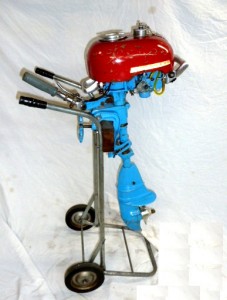

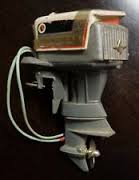

Recent Comments